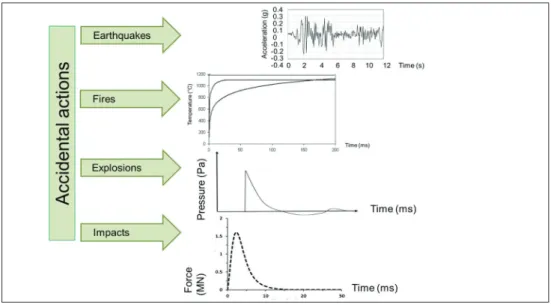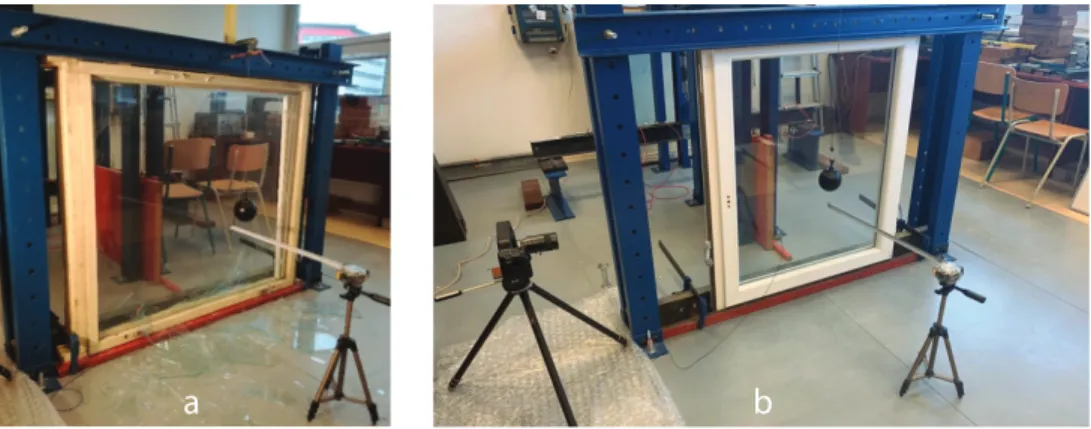Matúš Ivančo – Romana Erdélyiová – Lucia Figuli – Zuzana Zvaková
ANALYSIS OF SELECTED ASSETS AGAINST THE EXTRAORDINARY LOADS
DOI: 10.35926/HDR.2020.1.4
ABSTRACT: The current security situation in the world creates pressure to improve the pro- tection of critical infrastructure assets against negative events, such as bomb attacks, industrial accidents, explosions, or fire. The research at the Faculty of Security Engineer- ing is focusing on such extraordinary loads. The present paper analyses selected assets against extraordinary load and describes their experimental testing.1
KEYWORDS: critical infrastructure protection, extraordinary loads, explosion, fire
INTRODUCTION
The Faculty of Security Engineering, University of Žilina, prepares security engineering experts in courses Security sciences: Crisis management, Security management, Rescue ser- vices and Protection of critical infrastructure; as well as in a new study programme Security of Industry. Crisis management focuses on developing theory and practice of crisis manage- ment in public administration, risk management in business environment, solution of crisis phenomena, and investigating their economic, social, psychological and other background.
Security Management concentrates on the protection of people and property. The scientific research in the area of rescue services focuses on the organization and technology of fire safety, fire engineering, fire safety and fire prevention in technological processes and fire- fighting technology.
The research conducted at the faculty is based on the area of study courses. The common character is security and safety. The Faculty tried to cover the issue of security with interdis- ciplinary approach focusing on the prevention, repression, and effective solving of security problems and crisis phenomena. With knowledge in methods of crisis management such personnel are able to identify, analyse and assess risks in various types of environment, and to manage preventive activities and adequate response. The Faculty of Security Engineering educates crisis managers, rescue service workers, and experts in managing the processes of protection of persons and property. The scientific research focuses on the development of the theory and practice of security and protection of critical infrastructure, especially in the sectors of energy and transport.
1 This paper was supported by institutional grant project UNIZA I-19-028-18
EXTRAORDINARY LOADS
All types of threats to critical infrastructure elements, which can cause their failure or dam- age, could be considered as extreme loads. If the structure has to be safe and functional, it has to resist to external loads. The actions can be classified in accordance with various criteria.
In accordance with the standard valid for the design of structures in Europe (Eurocode 1), actions (loads), by the variation in time are divided into different classes.2 Permanent action (G) that is likely to act through a given reference period and for which the variation in mag- nitude with time is negligible (e.g. self-weight of structures, fixed equipment etc.); variable action (Q), variable in the time as imposed loads on building floors, beams and roofs, wind action or snow loads. And the third group is that of accidental actions (A), extraordinary loads of short duration, that are unlikely to occur with a significant magnitude on a given structure during its lifespan, but their consequences might be catastrophic.3 Such actions are earthquakes, fires, explosions or impacts (see Figure 1).
Figure 1 Accidental actions
EXPERIMENTAL TESTING
At the Faculty of Security Engineering various experimental tests were conducted to analyse the resistance of selected assets, as parts of critical infrastructure elements, on extraordinary loads. As such elements various structural elements were used.
2 Gulvanessian, H. and Holický, M. Designers’ Handbook to Eurocode 1: Basis of design. London: Telford, 1996.; Figuli, L. “Reliability of critical infrastructure elements”. Bánki Közlemények 1/2. 2018. 33-37.
3 Arteaga, A. “Classification of actions”. In Handbook 1: Basis of structural design: guide to interpretative doc- uments for essential requirements to EN 1990 and to application and use of Eurocodes. Garston Watford, 2004.
75-86.
Burglar resistance
The first experiment was focused on the determination of the dynamic resistance known as burglar resistance, i.e. the ability to withstand violent intrusion in protected rooms or areas following the application of physical force and with the aid of tools (6 different group of tools according to the security classes). As an examined asset glass windows were selected.4 The windows were fixed in the testing frame. Commercially used window systems were investigated during the experiment. Particular attention was paid to the sensitivity of the type and properties of the support frame to the impact. The nominal glass thickness was 3 mm for wooden samples and 4 mm for samples with PVC frames. In terms of glass size, dimensions are defined by the overall size of the window samples and frames used. The glass surface of the wooden frame windows was 1.22 x 1.05 m and 0.81 x 0.97 m of the PVC frame windows. The mounting of the wooden frame window in the test structure is shown in the following Figure 2.
Figure 2 Arrangement of the sample and the measuring instruments (a) wooden frame (b) PVC frame
During the experiment, 3 windows with a wooden frame and 1 with a PVC frame were used (see Figure 2). Various sizes of steel ball (2.644 kg and 4.571 kg) were used in the test, which were gradually released from pre-determined distances. Each measurement was re- corded with a high-speed camera and an accelerometer sensor. Individual drop heights were increased until the glass panel was damaged. Subsequently, the total impact energy values were evaluated.
The second round of testing of burglar resistance involved various barriers and parts of protection systems (safes, reinforced walls etc.), see Figure 3.
4 Figuli, L. et al. “Experimental investigation on the ball drop impact resistance of traditional glass windows”. In Gattuli, V., Bursi, O and Zonta, D. (eds.) ANCRiSST 2019 Procedia, 14th International Workshop on Advanced Smart Materials and Smart Structures Technology. Roma: Sapienza Università Editrice, 2019. 123-126.
a b
Figure 3 Testing of burglar resistance5
Blast resistance
The field tests were focusing on the measurement of overpressure and its influence on steel beams. POLONIT was used as the explosive. The weight of charges selected: 2.3 kg (pipe bomb), 4.5 kg (explosive belt) and 9 kg (bomb vest – it was not detonated because of a high overpressure of the 4.5 kg explosive charge which caused a damage to the steel beam struc- ture). The explosive charges were used together with 25 g of ignition explosive PLNp10. The sensors were placed at the height of 1.6 m, at the angle of 45° from the normal line in the dis- tances 2 m, 5 m, and 10 m from the source of the explosion (see figure 3). One of the sensors was orientated in parallel with the steel beams in the distance of 5.5 m opposite of a gabion wall and in the distance of 3 m from the source of explosion (we wanted to record the reflected blast wave). The explosive charges were placed at a wooden base at the height of 10 m. The structure consisted of a steel frame and four wide flange steel HEB 100 beams and 12 IPE 120 steel beams with a span of 1,770 mm. For convenience the beams were tested in the vertical positions and simply supported. They were loaded mainly to bending caused by the blast pres- sure as the axial stress due to the fact that self-weight was practically negligible.6
5 Boros, M. “Vplyv deštruktívnych prostriedkov na zisťovanie prielomovej odolnosti rôznych mechanických zábranných prostriedkov”. Thesis. University of Žilina, 2016.
6 Figuli, L. and Papan, D. “Single degree of freedom analysis of steel beams under blast loading”. Applied me- chanics and materials 617. 2014. 92-95. DOI:10.4028/www.scientific.net/AMM.617.92
Figure 4 Field tests – blast resistance
During the blast test pressure, strain and acceleration were measured. The measured parameters were compared with the analytical and numerical model. The behaviour of such blast loaded structures were described. Other tests were made by Štoller, J. and Zezulová, E.7
Fire resistance
The last area of testing and numerical simulation to describe the resistance of various el- ements was the research against the effect of fire. Fire resistance and loss of stability of selected structural elements were done. The elements were concrete elements with various area sections. Concrete beams with encased steel profiles (see Figure 4.)
Figure 5 Cross section of elements for fire resistance analyses
As we have already mentioned temperature distribution in a circular cross-section were examined. The elements were exposed to fire for the duration of 120 min. Numerical simu- lation was done using finite element methods in ANSYS (see Figure 6).
7 Štoller, J. and Zezulová, E. “The Application of Fibre Reinforced Concrete for Protective Shelter from Auxiliary Material”. Key Engineering Materials 755. 2017. 374-381. DOI:10.4028/www.scientific.net/KEM.755.374;
Štoller, J. and Zezulová, E. “Field Tests of Cementitious Materials Suitable for Force Protection and Critical Infrastructure Protection”. In 2019 International Conference on Military Technologies (ICMT), Brno: IEEE, 2019. 1-8. DOI:10.1109/MILTECHS.2019.8870067
Figure 6 Numerical simulation of temperature distribution by ANSYS finite element method
CONCLUSIONS
In order to predict the disruption of and damage to critical infrastructure elements it is important to take into account the structural resistance of such elements. A structural-reliability analysis of so called accidental actions is required. For structural-reliability analysis maximum load arising from the treat scenarios has to be set, and geometric and mechanical characteristics of the critical infrastructure element have to be known. The paper describes such treats in the form of extraordinary loads and the various tests conducted at the Faculty of Security Engineering.
BIBLIOGRAPHY
Arteaga, A. “Classification of actions”. In Handbook 1: Basis of structural design: guide to interpre- tative documents for essential requirements to EN 1990 and to application and use of Eurocodes.
Garston Watford, 2004. 75-86.
Boros, M. “Vplyv deštruktívnych prostriedkov na zisťovanie prielomovej odolnosti rôznych mechan- ických zábranných prostriedkov”. Thesis. University of Žilina, 2016.
Figuli, L. “Reliability of critical infrastructure elements”. Bánki Közlemények 1/2. 2018. 33-37.
Figuli, L., Bedon, C., Papán, D. and Papanova, Z. “Experimental investigation on the ball drop impact resistance of traditional glass windows”. In Gattuli, V., Bursi, O and Zonta, D. (eds.) ANCRiSST 2019 Procedia, 14th International Workshop on Advanced Smart Materials and Smart Structures Technology. Roma: Sapienza Università Editrice, 2019. 123-126.
Figuli, L. and Papan, D. “Single degree of freedom analysis of steel beams under blast loading”. Ap- plied mechanics and materials 617. 2014. 92-95. DOI:10.4028/www.scientific.net/AMM.617.92 Gulvanessian, H. and Holický, M. Designers’ Handbook to Eurocode 1: Basis of design. London:
Telford, 1996.
Štoller, J. and Zezulová, E. “The Application of Fibre Reinforced Concrete for Protective Shelter from Auxiliary Material”. Key Engineering Materials 755. 2017. 374-381. DOI:10.4028/www.
scientific.net/KEM.755.374
Štoller, J. and Zezulová, E. “Field Tests of Cementitious Materials Suitable for Force Protection and Critical Infrastructure Protection”. In 2019 International Conference on Military Technologies (ICMT), Brno: IEEE, 2019. 1-8. DOI:10.1109/MILTECHS.2019.8870067




